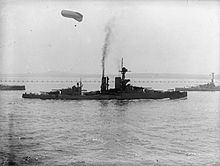Frederick Field (Royal Navy officer)
Commander of the Order of the Crown (Romania) (United States)Navy Distinguished Service Medal |
|---|
Early career
Born the second son of Colonel Spencer Field, 6th

After serving on the directing staff at the torpedo school
Promoted to commander on 26 June 1902,[5] Field was on the same day posted to HMS Vernon, in command of the torpedo gunboat HMS Jaseur.[6] He was posted to the battleship HMS Albion on the China Station in early August 1902,[7] before rejoining the staff at HMS Vernon in 1904.[1] Promoted to captain on 31 December 1907,[8] he became commanding officer of HMS Defiance, the torpedo school at Devonport.[9] He was given command of HMS Duncan as flag captain to Admiral Martyn Jerram, Commander-in-Chief of the Mediterranean Fleet in 1910 and then became superintendent of the Royal Navy signal schools in 1912.[9]
First World War

Field saw service during the
Flag officer
Promoted to the rank of
First Sea Lord
Field became
It was also primarily Field's work in the
Field retired as First Sea Lord in January 1933 and was promoted to
Family
In 1902, Field married Annie Jackson (née Harris); there were no children.[1]
References
- ^ a b c d e f g h i Heathcote, p. 74
- ^ "No. 26286". The London Gazette. 10 May 1892. p. 2704.
- ^ "No. 26388". The London Gazette. 4 April 1893. p. 2078.
- ^ "No. 27235". The London Gazette. 5 October 1900. p. 6104.
- ^ "No. 27448". The London Gazette (Supplement). 24 June 1902. p. 4198.
- ^ "Naval & Military intelligence". The Times. No. 36814. London. 8 July 1902. p. 11.
- ^ "Naval & Military intelligence". The Times. No. 36826. London. 22 July 1902. p. 11.
- ^ "No. 28096". The London Gazette. 3 January 1908. p. 34.
- ^ a b c d e f g h i Heathcote, p. 75
- ^ "No. 29751". The London Gazette (Supplement). 15 September 1916. p. 9064.
- ^ "No. 29751". The London Gazette (Supplement). 15 September 1916. p. 9070.
- ^ "No. 30116". The London Gazette (Supplement). 5 June 1917. p. 5591.
- ^ "No. 31000". The London Gazette. 8 November 1918. p. 13213.
- ^ "No. 31063". The London Gazette (Supplement). 10 December 1918. p. 14683.
- ^ "No. 31236". The London Gazette (Supplement). 14 March 1919. p. 3593.
- ^ "No. 31461". The London Gazette (Supplement). 15 July 1919. p. 9107.
- ^ "No. 31553". The London Gazette (Supplement). 12 September 1919. p. 11583.
- ^ "No. 31201". The London Gazette. 25 February 1919. p. 2738.
- ^ "No. 32782". The London Gazette (Supplement). 29 December 1922. p. 2.
- ^ "No. 32981". The London Gazette. 10 October 1924. p. 7327.
- ^ "No. 32978". The London Gazette. 30 September 1924. p. 7101.
- ^ "No. 33376". The London Gazette. 17 April 1928. p. 2740.
- ^ a b c d Heathcote, p. 76
- ^ "No. 33905". The London Gazette. 24 January 1933. p. 524.
- ^ "No. 33946". The London Gazette (Supplement). 2 June 1933. p. 3801.
- ^ "Royal Navy Club of 1765 and 1785 (United 1889)". Archived from the original on 31 August 2018. Retrieved 10 November 2012.
Sources
- Heathcote, Tony (2002). The British Admirals of the Fleet 1734 – 1995. Pen & Sword Ltd. ISBN 0-85052-835-6.
Further reading
- Murfett, Malcolm (1995). The First Sea Lords from Fisher to Mountbatten. Westport. ISBN 0-275-94231-7.
External links
- Biographical article on the HMS Hood website
- The Dreadnought Project: Frederick Field

